BY CHRIS SLAY
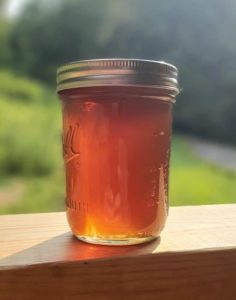 A quart of very fresh wildflower honey will taste like a sunny summer day all year long.
A quart of very fresh wildflower honey will taste like a sunny summer day all year long.
During the honey flow period, many established colonies made more honey than they need. In this four-part series, we’ll explore exactly what honey is, what differentiates some honey from others, traditional and modern medical uses, and the rich history humans have with honey as a food source. We’ll also disprove some common misconceptions about honey. Welcome back to the fascinating life cycle of the honey bee.
Honey begins as nectar from flowers. Worker bees collect nectar and pollen for food. The nectar that isn’t immediately consumed is stored in bees’ honey bellies and taken back to the hive. Honey bees’ salivary enzymes and proteins break down the nectar’s complex sucrose and starches into simple, more quickly digested sugars — glucose and fructose.
Because wild yeasts and bacteria can easily live on nectar, robbing its nutrients, honey bees reduce the nectar’s water content in two astonishing ways. First, they repeatedly regurgitate the nectar into their mandibles to create bubbles that provide a large surface area for water to evaporate. Second, after storing the partially dehydrated solution in open wax cells, groups of workers will constantly fan their wings, producing heat and airflow to reduce the water content even further. After the solution lowers to a water content of 18% to 15.5%, bees cap the cells with wax.
The nectar is now beyond the saturation point of water. This means there is far more sugar dissolved in what little water remains than ever could be dissolved in an equivalent volume of water.
For example, it’s impossible to dissolve one cup of sugar in seven teaspoons of water. This is honey.
Honey’s supersaturation of sugar is incredibly stable on molecular and chemical levels. Yeasts and bacteria are deterred from living on honey while in the capped cells, which ensures a very fresh and untainted food source.
The type of honey a colony produces depends entirely on the nectar’s primary source. Wildflower, the most abundant type of honey, is a combination of all of the thousands of different flowers from which the bees forage. Wildflower honey is typically light to dark amber in color and can have a very complex, multi-faceted taste. Other local nectar sources, such as basswood, tulip poplar, and sourwood trees, produce a much lighter-tasting, grassy-golden honey. Regardless of what the label says, no one knows what other flowers’ nectars are present without microscopically identifying the unique pollen cells in honey. Bees don’t discriminate.
At retail, honey is offered in many forms, but it’s either raw or processed. Most commercially produced honey is pasteurized, which ensures bacterial decontamination that may occur after uncapping the cells for extraction and the packaging process. Raising the temperature of honey above 104F also diminishes many of the unique qualities of honey. If you’ve ever had milk fresh from the cow, you understand. Commercial honey may also contain additives like high-fructose corn syrup or artificial coloring.
We are here to share current happenings in the bee industry. Bee Culture gathers and shares articles published by outside sources. For more information about this specific article, please visit the original publish source: All about honey – part 1 | Community News | thetomahawk.com
]]>The sweet stuff can help with burns, coughs, anxiety and more
By Alison Gwinn,
AARP
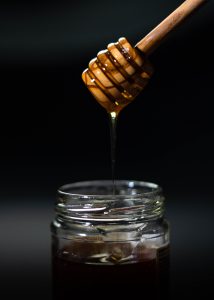
Photo by Daily Slowdown on Unsplash
Honey’s benefits have been touted since antiquity — and it turns out the ancient Greeks and Romans were onto something: Honey really can hit the sweet spot when it comes to our health.
Though honey — a sweet, sticky liquid made by honeybees from flower nectar — is technically a sugar, “it’s also really rich in a lot of different bioactive substances,” says Mayo Clinic registered dietitian (and hobbyist beekeeper) Joy Heimgartner. Those include a range of good-for-you minerals, probiotics, enzymes, antioxidants and other phytochemicals.
There are four common types of honey: Raw honey is defined by the National Honey Board as “honey as it exists in the beehive or as obtained by extraction, settling or straining without adding heat.” Manuka honey, produced from the flowers of manuka trees, is known for its unique antibacterial properties, attributed to a compound called methylglyoxal, says Jordan Hill, lead registered dietitian for Top Nutrition Coaching.
Organic honey is produced without the use of synthetic chemicals, pesticides or GMOs. And locally produced honey has been reported to provide relief from seasonal allergies to local pollen, though scientific evidence to support that claim is limited, says Hill.
According to Hill, honey can be substituted for sugar in recipes, but remember: It has a distinctive flavor (which varies depending on the source flowers); it’s sweeter than sugar (the general rule of thumb is to use ¾ to 1 cup of honey for every 1 cup of sugar); it’s a liquid, so you may need to cut back on other liquids or slightly increase the dry ingredients in a recipe; and it browns more quickly than sugar (so reduce the oven temperature by 25°F).
But whatever way you use honey — in a recipe or as a condiment — always keep in mind that it is a sweetener. “Honey is a supersaturated sugar solution, and we should limit added sugars of all types,” says Heimgartner. Still, “if you’re looking for a sweetener that has more to offer, honey is fantastic.” Here are six reasons why.
- Honey doesn’t raise your blood sugar as rapidly as white sugar
“Honey is metabolized differently from white sugar and produces less of a sugar spike,” says registered dietitian and nutritionist Dawn Jackson Blatner, author of The Flexitarian Diet. “Research suggests that honey may enhance insulin sensitivity and may support the pancreas, the organ that produces insulin.” A 2018 review of preliminary studies points to honey’s “hypoglycemic effect” and use as a “novel antidiabetic agent that might be of potential significance for the management of diabetes and its complications.”
And a 2022 study out of the University of Toronto found that honey improves important measures of cardiometabolic health, including blood sugar, cholesterol and triglyceride levels, especially if the honey is raw and from a single source.
- Honey can help with wound or burn therapy
“Honey has been used for wound healing for centuries, and certain types of honey, like medical-grade honey, have shown potential in wound management due to their antimicrobial properties and ability to promote healing,” says Hill, who nonetheless advises consulting health care professionals for appropriate wound care. Heimgartner, a board-certified oncology specialist, says, “There’s actually a lot of evidence that using honey during oral cancer radiation treatment helps to prevent some of the nasty side effects of mucositis,” or inflammation of the mouth.
How does it work? “Research suggests that honey prevents or controls the growth of bacteria on the wound, helps to slough off dead tissue and microorganisms, and transports oxygen and nutrients into a wound for quicker healing,” says Blatner.
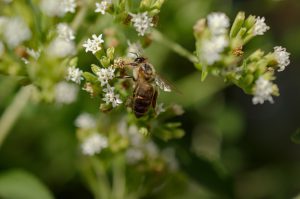
Native plants and naturalistic perennials attract bees and other pollinators.
Create Your Own Pollinator Garden
If you want to create your own pollinator garden for bees to forage in, consider these tips from Emily Erickson, postdoctoral researcher at the University of California, Davis, department of evolution and ecology.
- Opt for native plants or naturalistic perennials.
- Choose plants of varying colors, shapes and bloom times so you can support a variety of pollinators throughout the season.
- Avoid double-flowered varieties (those with extra petals) or plants that look drastically different from their wild relatives.
- Avoid pesticides.
- Leave areas in your yard that can serve as nesting habitats, such patches of bare soil, brush, twigs or woody stems, where many native pollinators make their homes.
- Which plants are right for you depends on your location and climate, so ask your local nursery for advice — or simply walk through a nursery and notice which plants seem to attract pollinators.
- Honey is rich in polyphenols, including flavonoids
Why does that matter? Because those two substances have both antioxidant and anti-inflammatory properties, meaning they protect our bodies against oxidative stress, which can manifest as cancer, heart disease or other diseases. But Hill cautions that the polyphenols in honeys can vary significantly, depending on the type of honey and its floral source.
- Honey can be an effective cough suppressant
A 2020 meta-analysis found that honey provides a widely available and inexpensive alternative to antibiotics in controlling cough frequency and severity, though it concluded that further studies were needed. “It is believed that honey’s thick texture and possible antioxidant and antimicrobial properties may provide relief for cough symptoms,” Hill says, but she adds the caveat that honey should never be given to infants under 1 year of age due to a risk of botulism.
- Honey may provide antidepressant or anti-anxiety benefits.
“Research suggests that polyphenol compounds in honey such as apigenin, caffeic acid, chrysin, ellagic acid and quercetin support a healthy nervous system, which may enhance memory and support mood,” says Blatner. Though more study is needed, a 2014 review of research says that one established nootropic (or cognitive-enhancing) property of honey “is that it assists the building and development of the entire central nervous system, particularly among newborn babies and preschool-age children, which leads to the improvement of memory and growth, a reduction of anxiety, and the enhancement of intellectual performance later in life.”
- Honey may support a healthy gut
Early research indicates that “honey has an extra-special ability to support a healthy gut microbiome because it contains both probiotics, or good bacteria, and prebiotic properties, which help good bacteria thrive,” says Blatner, though the evidence is limited. A 2022 paper funded by the National Institute of Health, Malaysia, concluded that “honey bees and honey, which have the potential to be good sources of probiotics and prebiotics, need to be given greater attention and more in-depth research so they can be taken to the next level.”
We are here to share current happenings in the bee industry. Bee Culture gathers and shares articles published by outside sources. For more information about this specific article, please visit the original publish source: https://www.aarp.org/health/healthy-living/info-2023/honey-health-benefits.html
]]> Fresh Broccoli with Honey
Fresh Broccoli with HoneyBy: Fay Jarrett
Ingredients
□ 4 cups chopped broccoli
□ ¼ cup honey
□ 1 tbsp olive oil (tuscan herb was used this time)
□ ½ tsp pepper
□ ½ tsp salt
Directions
Step 1
Place chopped broccoli in a large bowl.
Step 2
Sprinkle honey, olive oil, salt and pepper over top. Stir.
Step 3
Cook broccoli in the microwave for four to five minutes, until desired tenderness.
Note
This a great addition to pork chops with hot honey drizzled on top.
Enjoy this easy, delicious dinner!
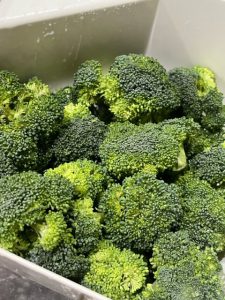

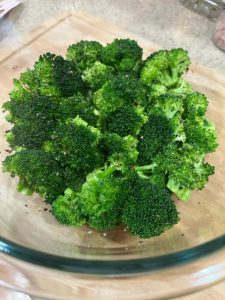
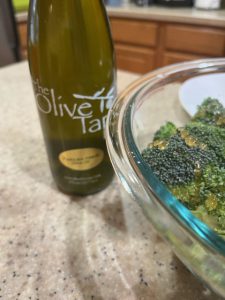
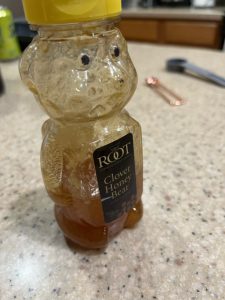
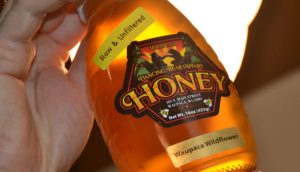
Kent Pegorsch of Dancing Bear Apiary recently won an award for his Waupaca Wildflower honey at the Black Jar Honey Tasting Contest, a competition to identify the best tasting honey in the world. James Card Photo
Local honey ranked world class
By James Card
Kent Pegorsch recently won an award that is the equivalent of the Super Bowl of beekeeping.
Pegorsch is the owner of Dancing Bear Apiary. He submitted his Waupaca Wildflower honey to the Black Jar Honey Tasting Contest organized by the Center for Honeybee Research.
The goal of the contest is to identify the best tasting honey in the world. The contest is named “Black Jar” because all of the honey jars are shrouded in a coded black bag so the judges only focus on taste and not color or clarity.
Each year 500 to 1,000 entries are submitted. Out of those, the judges picked 12 winners and the Waupaca honey was among them.
Other winning honeys came from Spain, South Carolina, Hungary, Alaska, Uruguay, Vermont, Netherlands, Kansas and two from Slovakia. The honey from Spain took the grand prize.
The Waupaca honey Pegorsch submitted won in the Medium Amber category. He entered for the first time the year before and he missed being in final 30 entries.
On Sunday, June 4, Pegorsch was working in his bee yard when he heard the news. Stephanie Slater, a fellow Wisconsin beekeeper and friend, was at the completion and called him.
“I just wanted to be the first to congratulate you that you’re in the finals,” Slater said. Then his cell phone reception cut out. He refreshed his phone over and over again.
Pegorsch was working with his son and they discovered the event was being live streamed online except there was no sound as the winners were being announced.
“It was a very intense day. They later confirmed it on Tuesday. I was a little hard to get along with for two days,” said Pegorsch. “This validates that I do know my honey is a really good tasting honey when competing against honeys from all over the world. That’s the most important thing that I get out of this contest and I will definitely be competing in future years,” he said.
We are here to share current happenings in the bee industry. Bee Culture gathers and shares articles published by outside sources. For more information about this specific article, please visit the original publish source: Sweet win for Waupaca bees – Waupaca County Post (waupacanow.com)
]]>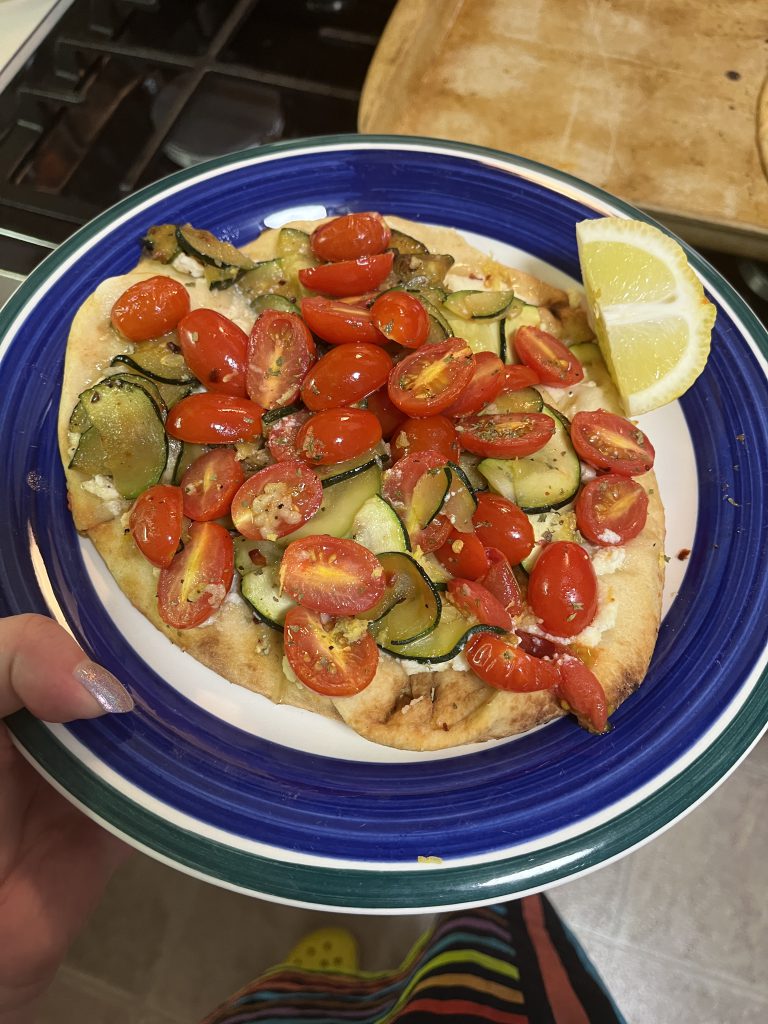 Zucchini & Tomato Flatbreads
Zucchini & Tomato FlatbreadsBy: Emma Wadel
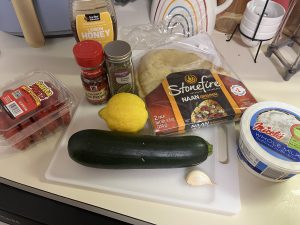 Ingredients
Ingredients
□ 1 zucchini
□ A small tub of grape tomatoes
□ 1 garlic clove
□ 1 lemon
□ 4oz of ricotta cheese
□ 2 flatbreads (I use the Storefire Naan 2-pack. I have found it holds its structure better than a pure flatbread.)
□ Parsley for garnish (fresh or the dried flakes)
□ Chili flakes (I use red pepper flakes)
□ Honey
□ Olive oil
□ Salt
□ Pepper
Directions
This recipe makes 2 servings.
Step 1
Place a lightly oiled baking sheet on the top rack and preheat the oven to 450 degrees.
 Step 2
Step 2
Trim and halve zucchini lengthwise. Thinly slice crosswise into half-moons.
Step 3
Halve tomatoes.
Step 4
Peel and mince or grate garlic. I will normally use a garlic press just to save some time – if you choose that, it will come in a later step.
Step 5
Zest and halve lemon. Quarter one of the halves.
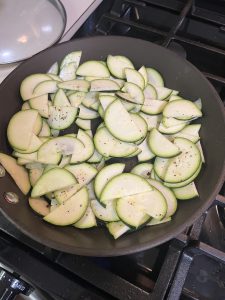
Step 6
Heat a drizzle of olive oil in a large pan over medium-high heat.
Step 7
Add zucchini to hot pan with some salt and pepper and cook, stirring, until lightly browned and softened. It should take around 5-6 minutes.
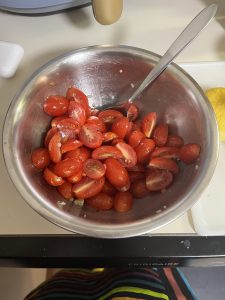 Step 8
Step 8
In a small bowl, combine tomatoes, garlic (this is the time to use the garlic press, if desired!), and a drizzle of olive oil. Season with salt and pepper.
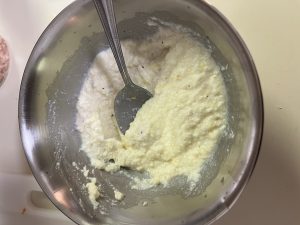 Step 9
Step 9
In a second small bowl, combine ricotta, half of the lemon zest, ½ teaspoon olive oil, salt, pepper, and lemon juice. I use half the lemon in a lemon squeezer.
Step 10
Once the oven is finished preheating and the prior steps have been completed, remove the baking sheet. Carefully place flatbreads on the prepared sheet.
 Step 11
Step 11
Evenly spread flatbreads with the lemon ricotta mix.
Step 12
Top with zucchini and tomatoes. Try to get the tomatoes with the cut sides up.
Step 13
Bake on the top rack until flatbreads are golden brown, about 10-12 minutes.
Step 14
If you’re using fresh parsley, pick the leaves from stems and roughly chop the leaves.
 Step 15
Step 15
Once flatbreads are done, garnish with honey, parsley, remaining lemon zest and chili flakes (to taste). Serve with remaining lemon wedges on the side.
By: Shana Archibald
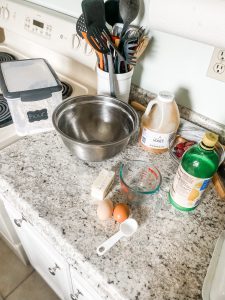 Ingredients
Ingredients
□ ½ cup butter (softened)
□ ⅔ cup honey
□ 2 eggs
□ 1 tablespoon lemon juice
□ ¼ teaspoon salt
□ Zest from half a lemon
□ ¾ cup flour
□ ¾ cup raspberries (or mixed berry blend,
which is what I used)
Glaze Ingredients
□ ¾ to 1 cup powdered sugar
□ 1 teaspoon raspberry jam
□ 1 tablespoon lemon juice
Directions
Step 1
Preheat oven to 350°F.
Step 2
Prepare an 8×8 square pan by spraying it with non-stick spray (or lining it with parchment paper).
Step 3
In a large bowl, combine butter, eggs, honey, lemon juice, salt and zest. Mix by hand or hand mixer.
Step 4
Add flour and mix until just combined.
Step 5
Add fresh raspberries (or mixed berries) and stir in by hand.
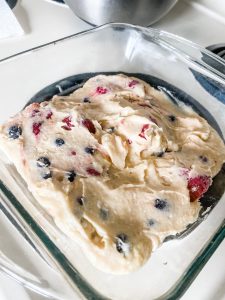 Step 6
Step 6
Pour into prepared pan and spread into an even layer.
Step 7
Bake for around 25 minutes or until edges are brown and the middle is set. Do not over bake! You want the texture to be like a brownie.
Step 8
Let it cool.
Step 9
While the bars are cooling, combine the glaze ingredients and whisk together.
Step 10
Pour it over the cooled bars and spread out into an even layer on the top. Let the glaze set for at least 20 minutes.
Step 11
Cut into squares and serve.
Store at room temperature or in the refrigerator in an air tight container. Enjoy!
]]>Intellectual Property Office rules that New Zealand beekeepers’ attempt to stop Australian producers using the name did not meet necessary requirements
Tess McClure in Auckland
New Zealand honey producers have lost their latest battle to trademark mānuka honey, the latest blow in a years-long fight to stop Australian beekeepers using the lucrative name.
The Intellectual Property Office of New Zealand ruled on Monday that New Zealand mānuka beekeepers’ attempt for a trademark did not meet necessary requirements, and the term mānuka was descriptive.
Mānuka refers to a white flowered tree that grows in both New Zealand and Australia – although it is more widely known as “tea tree” in Australia. The bees that browse its tiny pale blooms produce a kind of honey known for antibacterial and supposed health properties – and which fetches a significant price markup on the international market as a result.
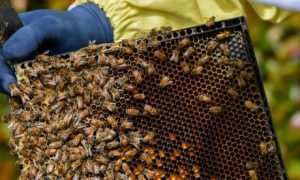
At the highest concentrations, some New Zealand batches have fetched up to NZ$2,000 to $5,000 for a 250g jar at luxury stores overseas. The lucrative nature of the product has been responsible for outbreaks of crime in New Zealand, with fierce competition over access to mānuka forests spurring mass poisonings of bees, thefts, vandalism and beatings.
For more than a decade, however, the two countries have been at loggerheads over the use of the mānuka name – a Māori word, which New Zealand argues is an indigenous treasure, uniquely associated with its own honey production. Pita Tipene, Chair of the Manuka Charitable Trust, said the decision was “disappointing in so many ways”. He said the trust would pause to regroup, before continuing its battle.
“If anything, it has made us more determined to protect what is ours on behalf of all New Zealanders and consumers who value authenticity,” he said.
“Our role as kaitiaki [guardians] to protect the mana [dignity] and value of our taonga [treasured] species, including mānuka on behalf of all New Zealanders is not contestable.”
Australian industry players welcomed the decision as a “commonsense outcome” and issued a press release saying they had plans to grow international sales in response to rising demand.
Australian Manuka Honey Association chairman Ben McKee said he was “delighted” by the ruling.
“Our product has a long history of being recognised as manuka honey, it is produced like the NZ product is, and it also offers the sought-after antimicrobial properties that consumers around the world value so highly,” he said.
New Zealand producers first tried to trademark the term in 2015.
The Intellectual Property Office of New Zealand called the fight “a trans-Tasman tussle of extraordinary proportions” and said in its ruling that it was “one of the most complex and long-running proceedings to have come before the Intellectual Property Office”. The latest decision follows a similar 2021 ruling from the UK to not grant trademark status.
We are here to share current happenings in the bee industry. Bee Culture gathers and shares articles published by outside sources. For more information about this specific article, please visit the original publish source: New Zealand loses fight with Australia over mānuka honey trademark | New Zealand | The Guardian
]]>Released March 17, 2023, by the National Agricultural Statistics Service (NASS), Agricultural Statistics Board, United States Department of Agriculture (USDA)
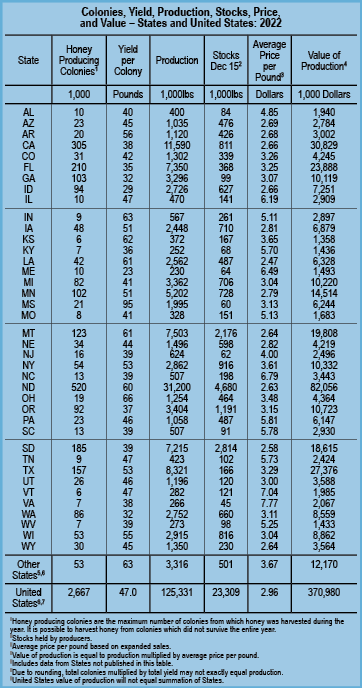 United States Honey Production Down One Percent in 2022
United States Honey Production Down One Percent in 2022
United States honey production in 2022 totaled 125 million pounds, down one percent from 2021. There were 2.67 million colonies producing honey in 2022, down one percent from 2021. Yield per colony averaged 47.0 pounds, unchanged from 2021. Colonies which produced honey in more than one state were counted in each state where the honey was produced. Therefore, the United States level yield per colony may be understated, but total production would not be impacted. Colonies were not included if honey was not harvested. Producer honey stocks were 23.3 million pounds on December 15, 2022, down one percent from a year earlier. Stocks held by producers exclude those held under the commodity loan program, which are entered separately.
Honey Prices Up 12 Percent in 2022
United States honey prices increased 12 percent during 2022 to $2.96 per pound, compared to $2.65 per pound in 2021. United States and state level prices reflect the portions of honey sold through cooperatives, private and retail channels. Prices for each color class are derived by weighing the quantities sold for each marketing channel. Prices for the 2021 crop reflect honey sold in 2021 and 2022. Some 2021 crop honey was sold in 2022, which caused some revisions to the 2021 crop prices.
Price Paid for Queens, Packages, Nucs was 22 Dollars in 2022
The average prices paid in 2022 for honey bee queens, packages and nucs were $22, $98 and $129, respectively. Pollination income for 2022 was $241 million, down 11 percent from 2021. Other income from honey bees in 2022 was $55.2 million, down 31 percent from 2021.
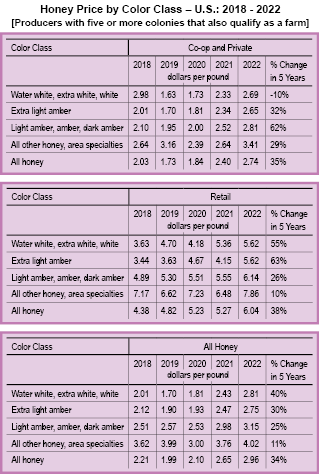 Released August 1, 2022, by the National Agricultural Statistics Service (NASS), Agricultural Statistics Board, United States Department of Agriculture (USDA).
Released August 1, 2022, by the National Agricultural Statistics Service (NASS), Agricultural Statistics Board, United States Department of Agriculture (USDA).
January 1, 2021 – Some History
Honey Bee Colonies Down One Percent for Operations with Five or More colonies
Honey bee colonies for operations with five or more colonies in the United States on January 1, 2022 totaled 2.88 million colonies, down one percent from January 1, 2021. The number of colonies in the United States on April 1, 2022, was 2.92 million colonies. During 2021, honey bee colonies on January 1, April 1, July 1 and October 1 were 2.90 million, 2.83 million, 3.17 million and 3.09 million colonies, respectively.
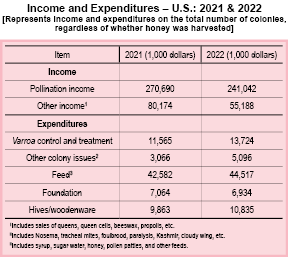
Honey bee colonies lost for operations with five or more colonies from January through March 2022, was 331,780 colonies, or 12 percent. The number of colonies lost during the quarter of April through June 2022, was 282,630 colonies, or 10 percent. During the quarter of January through March 2021, colonies lost totaled 464,640 colonies, or 16 percent, the highest number lost of any quarter surveyed in 2021. The quarter surveyed in 2021 with the lowest number of colonies lost was July through September, with 295,660 colonies lost, or nine percent.
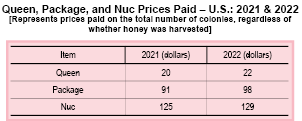 Honey bee colonies added for operations with five or more colonies from January through March 2022 was 367,890 colonies. The number of colonies added during the quarter of April through June 2022 was 589,630. During the quarter of April through June 2021, the number of colonies added were 665,730 colonies, the highest number of honey bee colonies added for any quarter surveyed in 2021. The quarter of October through December 2021 added 93,940 colonies, the least number of honey bee colonies added for any quarter surveyed in 2021.
Honey bee colonies added for operations with five or more colonies from January through March 2022 was 367,890 colonies. The number of colonies added during the quarter of April through June 2022 was 589,630. During the quarter of April through June 2021, the number of colonies added were 665,730 colonies, the highest number of honey bee colonies added for any quarter surveyed in 2021. The quarter of October through December 2021 added 93,940 colonies, the least number of honey bee colonies added for any quarter surveyed in 2021.

Honey bee colonies renovated for operations with five or more colonies from January through March 2022 was 187,180 colonies, or seven percent. During the quarter of April through June 2022, the number of colonies renovated were 492,410 colonies, or 17 percent. The quarter surveyed in 2021 with the highest number of colonies renovated was April through June 2021 with 475,750 colonies renovated, or 17 percent. The quarter surveyed in 2021 with the lowest number of colonies renovated was October through December 2021, with 146,520, or five percent. Renovated colonies are those that were requeened or received new honey bees through a nucleus (nuc) colony or package.
Varroa Mites Top Colony Stressor for Operations with Five or More Colonies
Varroa mites were the number one stressor for operations with five or more colonies during all quarters surveyed in 2021. The period with the highest percentage of colonies reported to be affected by varroa mites was April through June 2021 at 50.7 percent. The percent of colonies reported to be affected by varroa mites during January through March 2022 and April through June 2022 are 33.7 percent and 45.2 percent, respectively.

Colonies Lost with Colony Collapse Disorder Symptoms Up 12 Percent for Operations with Five or More colonies
Honey bee colonies lost with Colony Collapse Disorder symptoms on operations with five or more colonies was 86,070 colonies from January through March 2022. This represents a 12 percent increase from the same quarter in 2021.
If you want to explore USDA’s survey results further, start here:
Access to NASS Reports are available for your convenience, you may access NASS reports and products the following ways:
-
- All reports are available electronically, at no cost, on the NASS website: www.nass.usda.gov.
- Both national and state specific reports are available via a free e-mail subscription. To set-up this free subscription, visit www.nass.usda.gov and click on “National” or “State” in upper right corner, above the “search” box to create an account and select the reports you would like to receive.
- Cornell’s Mann Library has launched a new website housing NASS’s and other agency’s archived reports. The new website: https://usda.library.cornell.edu. All email subscriptions containing reports will be sent from the new website, https://usda.library.cornell.edu. To continue receiving the reports via e-mail, you will have to go to the new website, create a new account and re-subscribe to the reports. If you need instructions to set up an account or subscribe, they are located at: https://usda.library.cornell.edu/help. You should whitelist [email protected] in your email client to avoid the emails going into spam/junk folders.
Per Capita Consumption, 2022
We calculate this figure each year using data from USDA ERS, NASS, ERS, FARM SERVICE and the U.S. Census Bureau. From these sources we determine how much honey entered the system, how much honey left the system, how much was used, how much wasn’t used and the population on July 1, 2022. These figures include U.S. production, U.S. exports, honey put under and taken out of the loan program and honey remaining in storage, plus how much was imported from off shore. Essentially, it’s a measure of honey in minus honey out. The resultant figure, divided by how many people were here on that particular date results in how much honey was consumed by each and every individual in the U.S. last year. And yes, you are correct, not every person eats honey, but by producing this figure on an annual basis, we are able to compare apples to apples each year in honey consumption.
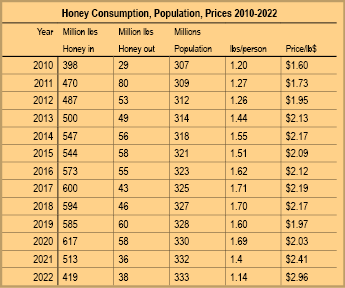 The chart compares these figures for the previous 13 years. We’ve included the USDA’s price of all honey for comparison too.
The chart compares these figures for the previous 13 years. We’ve included the USDA’s price of all honey for comparison too.
Honey Into the U.S., 2022
U.S. beekeepers with more than five colonies in 2022 produced, according to USDA, 125.3 million pounds of honey. The Honey Board calculates that an additional eight million pounds or so are produced by those with fewer than five colonies for a total production of 133.3 million pounds. Additional honey in figures include 23.3 million pounds taken out of warehouses from last year, two million pounds taken out from last year’s loan program and a whopping 260.9 million pounds imported for a rough total of 419.5 million pounds of honey in, during 2022. This honey sold, on average, wholesale, retail and specialty honey for $2.96/pound, according to USDA figures. Commercial beekeepers in the U.S. will tell you to make a living, this price should be about the same price as diesel fuel. Take a look next time you are at the gas station.
Honey Out of U.S. Stock, 2022
For the honey out figure, we exported nearly 12.3 million pounds to other countries, have nearly 23.3 million pounds still sitting in warehouses and put just under two million under loan, for a total of about 38 million pounds of honey produced in 2022 that were moved out of the U.S. figures for 2022.
The July 1, 2022 population was right at 333.3 million people in the U.S. So, to calculate per capita consumption, subtract honey out (put under loan, exported or still in warehouses) from honey in (honey produced this year, left over from last or imported) and divide by 333.3 million, for a total of 382 million pounds consumed in the U.S. last year. Divide this by 333 million people which gives you about 1.2 pounds of honey per person consumed by people in the U.S. during 2022, the lowest since 2012.

The top 10 producing states produced a total of $8,844,300 with a total of 1.879 million colonies. This comes to 70.4% of the U.S. colonies, and 70.6% of total dollar value.
The top three producing states had a total of 982,00 colonies, producing a total of $51,111,000. This comes to 36.8% of all colony production in the U.S. in 2022, producing 57.8% of total production dollars. Moreover, these three states produced 36.8% of all the colonies in the U.S. in 2022.
Top 10 Producing States
The places that yield the most honey every year are pretty much determined by the climate, the soil, agriculture and politics. The crops grown, or not grown in a region certainly play a role in what can be found relative to nectar, pesticides and regulations relative to how many colonies you can put on any given acre, that won’t starve after a couple of months. Of course, government conservation programs lend a hand here too.
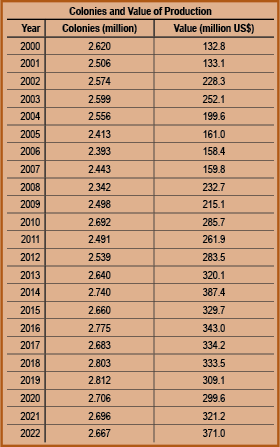
We’ve been curious about this for the last eight years or so, just because it’s interesting to see what changes, and what doesn’t. The Dakotas, California, Montana, Florida, Minnesota, and Texas are almost always in the top eight, with the last two changing occasionally: New York, Louisiana, Georgia, Idaho, Michigan and perhaps a few others round out these performers.
This year provided few surprises in who is on the list, and the totals for the top 10 this year were essentially where they always are relative to the number of colonies counted in these states and the amount of honey produced. Again, these states produced 70% of all of the honey produced in the U.S., and had 70% of all the colonies in the U.S. sitting somewhere within their borders. It’s pretty clear that what happens in these few states is going to determine the U.S. crop.
But, just because we can, this year we looked at the contributions of the top three states, for almost every year, the Dakotas and Texas. Combined, they held on to 52.3% of the colonies used last year and produced just over 40% of all the honey U.S. beekeepers made last year. This means, of course, that 52% of the colonies, and 60% of the U.S. honey crop is spread out over the remaining 47 states. You can see this comes to just under 1%/state. That sort of puts us in our place, doesn’t it? This extreme unbalanced situation commands notice, then, as to what will happen when climate change erodes, or doesn’t, weather patterns in these three states including rainfall, Summer and Winter temperatures, farming practices and conservation practices.
Already, drought in the western third of the U.S. is having an effect, not only on the bees, but their forage and the crops they pollinate as well. Like it or not, we are at the mercy of big weather – call it climate change or whatever – it’s dry out there!
Released January 11, 2023, by the National Agricultural Statistics Service (NASS), Agricultural Statistics Board, United States Department of Agriculture (USDA)
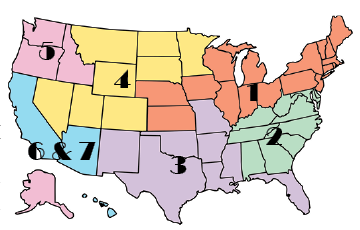
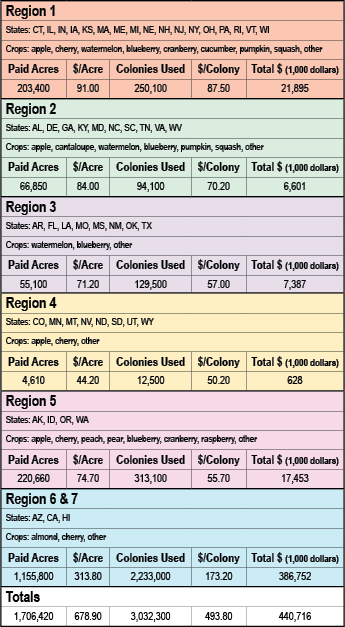 Pollination Costs and Income, 2022
Pollination Costs and Income, 2022
Cost Per Colony to Pollinate Almond Up 13 Percent from 2017
In Regions 6 & 7, the average cost per colony for almonds increased 13 percent from 171 dollars per colony in 2017 to 194 dollars per colony in 2022. The average price per acre increased from 272 dollars per acre to 336 dollars per acre during that period. The total value of pollination for almonds increased 44 percent. Almonds were the highest valued crop in that region. The total value of all pollination in Regions 6 & 7 for 2022 was 387 million dollars, up 42 percent from 2017.
Blueberries had the highest total value of pollination of crops reported in Region 1 in 2022. The price per colony for blueberries increased 27 percent to 98.4 dollars per colony in 2022. The price per acre increased 42 percent to 179 dollars per acre. The total value of pollination for blueberries in Region 1 for 2022 was 8.56 million dollars. The total value for pollination of all crops in Region 1 for 2022 was 21.9 million dollars, up 33 percent from 2017.
Blueberries had the highest total value of pollination of crops reported in Region 2 in 2022. The price per colony for blueberries increased 40 percent to 78.3 dollars per colony in 2022. The price per acre increased 63 percent to 139 dollars per acre. The total value of pollination for blueberries in Region 2 for 2022 was 3.60 million dollars. The total value of pollination of all crops in Region 2 for 2022 was 6.60 million dollars, up 10 percent from 2017.
Watermelons had the highest total value of pollination of crops reported in Region 3 in 2022. The price per colony for watermelons increased 38 percent to 76.9 dollars per colony in 2022. The price per acre increased 57 percent to 100 dollars per acre. The total value of pollination for watermelons in Region 3 for 2022 was 1.85 million dollars. The total value of pollination of all crops in Region 3 for 2022 was 7.39 million dollars, up eight percent from 2017.
Apples had the highest total value of pollination of crops reported in Region 4 in 2022. The price per colony for apples increased three percent to 51.7 dollars per colony in 2022. The price per acre decreased slightly to 41.0 dollars per acre. The total value of pollination for apples in Region 4 for 2022 was 114 thousand dollars. The total value of pollination of all crops in Region 4 for 2022 was 628 thousand dollars, down 27 percent from 2017.
Apples had the highest total value of pollination of crops reported in Region 5 in 2022. The price per colony for apples increased 12 percent to 58.3 dollars per colony in 2022. The price per acre increased 36 percent to 62.8 dollars per acre. The total value of pollination for apples in Region 5 for 2022 was 6.59 million dollars. The total value of pollination of all crops in Region 5 for 2022 was 17.5 million dollars, up four percent from 2017.
]]>By: Fay Jarrett & Lexi Nussbaum, PowerPose Nutrition
Ingredients
□ 2 cups (400g) active and bubbly natural yeast starter
□ 2½ cups (580g) warm water
□ ¾ cup (255g) honey
□ 1 egg, beaten
□ 1 tbsp (20g) salt
□ ⅓ cup (68g) avocado or coconut oil
□ 8-11 cups flour (unbleached all-purpose, bread flour or whole wheat flour is suggested)
Directions
Step 1
In a mixer or large bowl, combine the natural yeast, water, honey, salt, egg and oil.
Step 2
Add the flour, one cup at a time, mixing and kneading as it is added.
Step 3
Be careful not to add too much flour. When the dough starts to pull away from the bowl and there are places the flour is not mixed entirely, let the dough rest for 10-20 minutes.
Step 4
After the rest, continue to add flour. If you are using a Bosch mixer, the dough will become lopsided – at that point, you know you’ve added enough flour. You want the dough to be tacky, not sticky.
Step 5
Knead the dough for 10 minutes.
Step 6
Cover the dough with a clean dish towel or with the lid to the mixer. Allow to rise until doubled in size (approximately six hours). You can also let it rise longer if you’re wanting a more fermented taste or to reduce the gluten. I often let it rise overnight for 10 hours or so on the countertop. To speed up the rise, put it in the oven (off) with the oven light on.
Step 7
When the dough has doubled in size, empty onto a lightly oiled surface and divide into three to four equal portions. With practice, you will learn what quantity of dough works best for the size of your bread loaf pans. Form the dough into loaves and put each loaf into a greased or parchment lined bread pan.
Step 8
Cover again and let loaves rise until doubled. Anywhere from three to five hours.
Step 9
Once doubled, bake at 400 degrees for 28 minutes, or until the internal temperature reaches 180 degrees.
Step 10
When the loaves come out of the oven, immediately remove the loaves from the pans and set on a cooling rack to prevent condensation. Add butter to the tops if desired.
Step 11
Let bread cool before slicing.
Step 12
Enjoy!
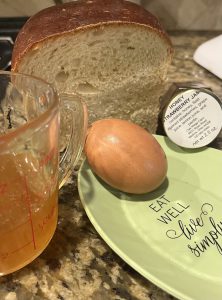
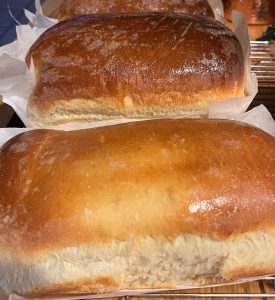
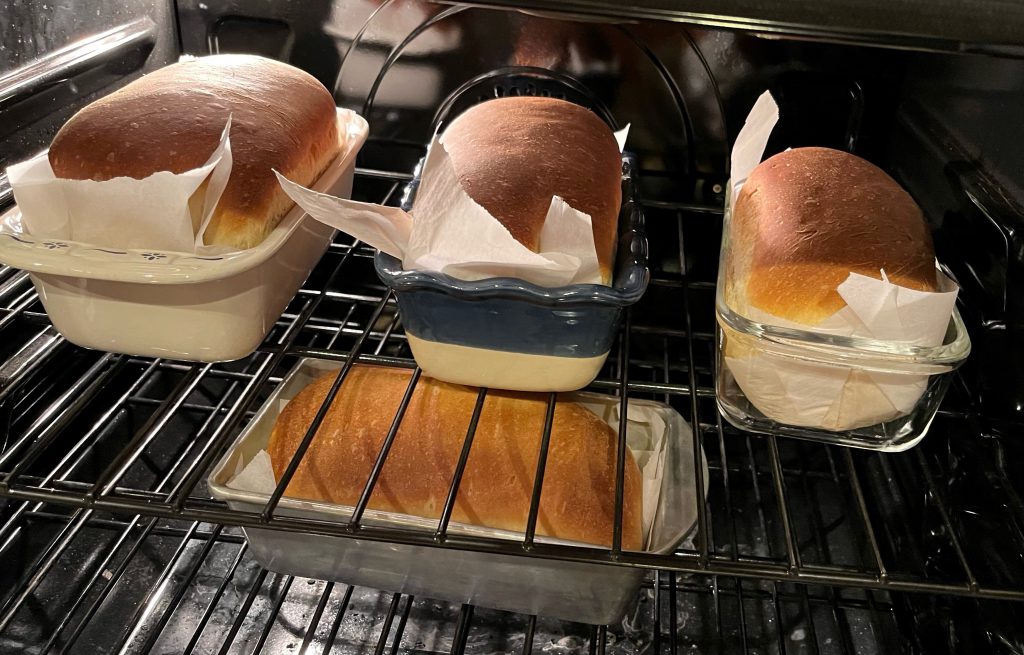
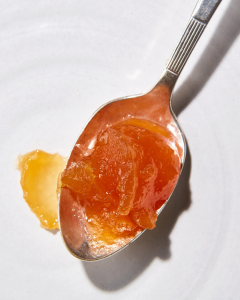
Don’t get rid of that last inch of solidified honey in the jar. Do this instead.
BY ANNA HEZEL
When archaeologists excavated King Tut’s tomb in 1922, they found (and allegedly tasted) a jar of honey that had survived the past several millennia intact. I think of this every time I come across a jar of honey in my kitchen that I helped harvest a full four years ago from bee hives my Brooklyn community garden keeps on the roof of my apartment building.
Although it’s a romantic idea to preserve the smells and tastes of Prospect Park’s flora from summer 2019 for posterity, I’m not keeping it around for sentimental reasons. I just can’t, for the life of me, get the jar open. And since this is the only container in my entire pantry without an expiration date printed on it, I’ve decided to procrastinate figuring it out…indefinitely.
While the King Tut story is oft-repeated to demonstrate that honey lasts forever, I’ve always wondered how this could be true when I’ve watched so many half-eaten jars over the years crystallize and solidify to a point of unusability. I reached out to Bruce Shriver, the beekeeper at Gowanus Apiary; Amy Newsome, a gardener, beekeeper, and author of Honey; and the folks behind Brooklyn-based Mike’s Hot Honey to get some practical advice on how to keep this natural sweetener at its free-flowing, floral best.
Does honey go bad?
At its core honey is essentially a very concentrated sugar solution, and because it has such a low water content (about 18%), it’s very resistant to fermentation or spoilage. It’s also full of organic acids from the nectar it’s made from, which give the honey an average pH of 3.4 to 6.1. This acidic quality makes it very difficult for microbes to survive in that jar or squeeze bottle.
“Honey lasts forever as long as it’s stored in an airtight container, such as a jar with a cap,” explains Shriver. The problems arise when the honey is exposed to air and humidity. “Honey will absorb moisture from the air if left open, which can cause it to ferment.”
When the moisture level changes, and the fermentation process begins, those sugars can be converted to alcohol. Mead is made by diluting honey with lots of water, and mixing it with yeast to kickstart that fermentation process. But if your jar is sealed and sheltered from extra humidity, it will last indefinitely. And, according to the USDA, even if you notice it getting cloudy or taking on a crystallized texture, the honey is still safe to eat.
Why does honey crystallize and turn solid sometimes?
“When bees make honey, they are creating a ‘supersaturated solution,’ which in this case means the natural sugars (mainly glucose and fructose—from the harvested flower nectar) are dissolved in a tiny amount of water, and the honey stays liquid but very temperamentally so,” explains Newsome. “The sugars start to crystallize over time.”
“All honey will crystallize over time,” agrees Shriver. “Commercially processed honey tends to crystalize more slowly than raw honey. That’s because all of the particles (mostly pollen grains) have been filtered under high pressure and heat. This process not only removes the pollen but also destroys many of the naturally occurring yeasts, enzymes, flavonoids, polyphenols and microbial compounds.”
The way honey solidifies is also partially decided by the bees themselves, when they choose which blossoms to land on.
“Each flower species has a different proportion of glucose to fructose in its nectar, and glucose crystallizes more readily than fructose,” Newsome explains. “This is why you can buy naturally runny honeys, like acacia, which has a higher fructose ratio.”
What can you do to prevent or fix it?
Newsome tells me that she saw an Instagram post recently that made her want to cry, suggesting that you can prevent crystals from forming by stirring some corn syrup into your honey. A section of her book, called “Crystallization is not the enemy,” suggests embracing the thicker, grainy texture and spreading it on crumpets or toast.
“I know it can be a pain,” she says, of the sweet but finicky syrup, “but really we should learn to love it and work with it, as a quirk of the natural world, and marvel that the bees have managed to make something so mercurial and delicious.”
When I reached out to the folks at Mike’s Hot Honey with a few questions on the subject, they sent me an informational pamphlet on the subject (presumably they get this question a lot). The pamphlet recommends keeping honey below 50° Fahrenheit for long-term storage, since this cooler temperature prevents crystallization. This will slow down how easily the honey flows, so they also recommend allowing it to warm back up to room temperature before using. If you’re using your honey frequently, they recommend keeping it between 70° and 80° Fahrenheit—a range that will delay crystallization.
But if you don’t have the luxury of tomb-like, cold storage conditions, you can always bring your solidified honey back to life with a little heat. Just set the jar or squeeze bottle in a bowl of warm water (but avoid water over 95° Fahrenheit, which can degrade some of the flavonoids, according to Shriver) until it starts flowing again.
We are here to share current happenings in the bee industry. Bee Culture gathers and shares articles published by outside sources. For more information about this specific article, please visit the original publish source: Why Does Honey Crystallize? (And How to Decrystallize It Naturally) | Epicurious
]]>The Texas Legislature wants to crack down on who can claim their honey is made in Texas. Beekeepers say the proposed legislation is too stiff and doesn’t take into account real-world production issues.
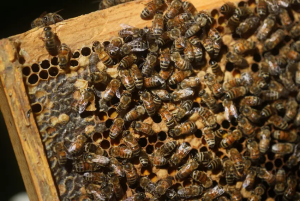
State lawmakers are debating a bill that would forbid Texas beekeepers from labeling their product as made in Texas if it contains a single drop of honey from another state. Beekeepers say the legislation doesn’t take into consideration real-world production problems. Credit: Joe Rondone/The Commercial Appeal-USA TODAY via REUTERS
State lawmakers are moving forward with a bill that could potentially land Texas honey producers in jail for mislabeling their products, creating a buzz in the beekeeping community.
House Bill 590, authored by Rep. Ernest Bailes, R-Shepherd, states that a product cannot be labeled as “Texas honey” unless the product consists “exclusively” of honey produced from apiaries in the state.
While the concept of the bill seems simple, Texas beekeepers say it could sting producers and their livelihood. According to Texas A&M’s AgriLife agency, Texas contributed 8.9 million pounds of honey — worth $17 million — to the national honey production.
“There’s a lot of things out there we need to address in labeling honey; this one is just not quite where it needs to be,” said Dodie Stillman, president of the Texas Beekeepers Association.
Running one of Texas’ 157,000 honey-producing colonies can get complicated. Weather conditions could make it difficult to produce enough honey for a business, so some will create a Texas-heavy blend with honey from other states. Relabeling products can get expensive or even lead to a loss for some producers. Beekeepers on border territories can have nectar DNA that inevitably blends between the two states.
But even with all the room for error, HB 590 would effectively make mislabeling Texas honey products a class B misdemeanor and potentially send a producer to jail for up to 180 days.
In an effort to soften the legislation, Rep. Cecil Bell Jr., R-Magnolia, proposed an amendment that would allow honey producers to label their product “made in Texas” as long as it consisted of “predominantly” Texas honey.
“This bill is not a bad bill inherently, but I do think if we don’t pay attention to what’s going on, there may be some consequences,” Bell said during a recent debate on the House floor.
Rep. Brian Harrison, R-Midlothian, spoke in support of Bell’s amendment, explaining how his constituents could also be affected because of how the bill is tailored.
“How many of our constituents do you think we should subject to …Texas prisons, who have done nothing more than make and sell honey?” Harrison asked.
Bell answered, “If we have one in jail, that’s more than we need to have in jail for producing Texas honey.”
The amendment ultimately failed.
The bill’s genesis came from a constituent in Bailes’ district. The state’s beekeepers association is neutral on the bill, an association spokesperson said.
“I think everybody agrees helping consumers know where their honey is from is a good idea,” said Leesa Hyder, the association’s legislative committee leader. “The question is, does this bill really do that?”
Hyder added there’s also a concern about how producers can prove their honey was made in the boundaries of the state.
Hyder said there was not time or opportunity for the association to address the problems with the bill — such as potential for consumer confusion, legal battle for producers and the uncertainty on whether this will even help make Texas honey more profitable. The association will remain neutral on the bill as it moves over to the Senate in coming weeks.
During the debate, Bailes compared it to his ranching business in defense of the bill.
“If we have a drought, and I have cattle grazing on grass, for grass-fed beef, and I start feeding them grain, it’s no longer grass-fed beef,” Bailes explained. “That’s as simple as it gets. We are better than simply saying it should be ‘predominantly’ and dilute ourselves for the almighty dollar.”
We are here to share current happenings in the bee industry. Bee Culture gathers and shares articles published by outside sources. For more information about this specific article, please visit the original publish source: Texas beekeepers face possible jail time under proposed legislation | The Texas Tribune
]]>By: Shana Archibald
Ingredients
□ ⅔ cup nonfat, plain Greek yogurt
□ 1 tablespoon cocoa powder
□ 1 teaspoon honey
□ ¼ cup fresh raspberries or strawberries
□ 2 tablespoons dark chocolate chips, melted
□ 2 tablespoons spray whipped cream topping (optional)
Directions
Step 1
Stir the Greek yogurt, cocoa powder and honey in a bowl.
Step 2
Add the fresh berries of choice.
Step 3
Place the chocolate chips in a bowl and heat in the microwave for 30 seconds at a time until melted and smooth; stirring in between.
Step 4
Drizzle the chocolate over the raspberries.
Optional Step 5
Top with whipped cream if desired.
 EMU researchers are chemically “fingerprinting” different varieties of honey
EMU researchers are chemically “fingerprinting” different varieties of honey
The team is working towards picking up chemical cues in honey to tell the botanical sources of the sweet treat
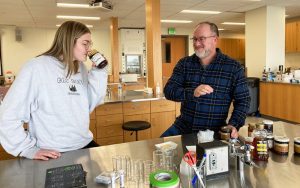
Grad Assistant Taylor Mac, left, and professor Cory Emal test different types of honey using a variety of methods including taste and aroma.
While Michigan is well-known as a leader in craft brewing, its status as a vanguard in the production of mead—made from fermented honey—is becoming more visible. And like fancy chefs who want to know the origins of every ingredient in their signature dishes, mead-makers are increasingly interested in knowing everything about the honey they use, right down to which plants the bees visited on their daily rounds. Enter EMU chemistry professor and amateur mead-maker Cory Emal, Ph.D. (Emal is also the coordinator of EMU’s Fermentation Science program.)
Leading a team of colleagues and students, Emal is developing a new way to analyze the unique chemical “fingerprint” of honey varieties. The goal of the research is a fast and robust test that will yield a detailed history and provenance of the sweet syrup.
Currently, it can be hard to verify claims on a label and there have been documented instances of honey fraud. A specific variety of honey can be adulterated with other varietals or even with corn or rice syrup. In one case, bees harvesting from the New Zealand mānuka plant made 1,700 tons of honey, but more than 10,000 tons of mānuka honey were sold.
Our five senses can identify honey to a certain point. In Emal’s sensory analysis class, students learn to interpret the unique tastes and aromas that distinguish one honey from another. For instance, meadowfoam honey has a distinct vanilla flavor, while buckwheat honey can be malty or minty. Varieties also range in color from pale yellow to deep molasses.
Brewers and chefs have to trust their senses and the honey labels for reassurance they are getting what they want, but most differences are subtle enough to confuse even the most discriminating palette. The best alternative is a microscopic analysis of pollen grains, a process Emal calls “expensive and labor intensive.”
In a new approach, Emal and his colleagues use nuclear magnetic resonance, or NMR, to pull out subtle chemical differences in honey. An NMR machine works like a magnetic resonance imaging (MRI) machine, but “instead of looking at somebody’s knee, we’re looking at chemical molecules,” explains associate professor of chemistry Gregg Wilmes, Ph.D. “It’s probably the most powerful tool that we have to figure out the structure of molecules, especially organic molecules.”
A number of EMU students have been involved in the project. Undergraduates Alia Frederick, Aubrey Martin, and Maggie McCullough came up with the best sample preparation method and ran the initial data collection on the NMR. Grad student Justin Norris dug through the dizzying spectral data and figured out a good way to process the data. Norris also came up with an organizational method to sort data and start building the spectral honey variety library.
“Every molecule is going to have its own distinct pattern,” says Wilmes. “What we are trying to do is use this to figure out the patterns in honey.”
The team ran five honey varietals through the NMR looking for distinct patterns of peaks in the readout. On first look, the results looked very similar to those for the sugar molecules. “Where we see the differences is when we really zoom in,” says Emal. “Here’s where we can start to see the minor compounds. These are the things that are going to be that signature for the individual types of honey.”
To see if these smaller peaks could tell the difference, Emal and Wilmes enlisted the help of biology lecturer Maria Goodrich, who ran the results through statistical analysis to pull out the parts that best represent a certain honey variety. They found that the five honeys tended to group together by variety. Their work is in the early stages, but so far there seems to be a distinctive chemical fingerprint that can separate one honey from another.
Eventually, they would like to build a library of the chemical traits of honey. As they build their catalog, they hope to be able to tell whether bees visited an orange grove in California, Florida, or Panama. “Even from season to season, because we don’t know what effects climate change is going to have over the years on honey traits,” Emal says. “We want to be able to build a big enough library of trusted samples, so that we have a better idea of the provenance of the honey.”
Visit the EMU Department of Chemistry website to learn more about program offerings and research projects.
We are here to share current happenings in the bee industry. Bee Culture gathers and shares articles published by outside sources. For more information about this specific article, please visit the original publish source: EMU researchers are chemically “fingerprinting” different varieties of honey – EMU Today (emich.edu)
]]>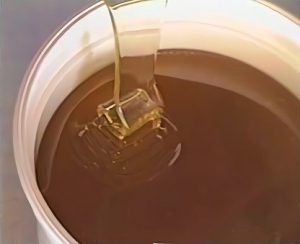
Companies covered in honey market are Bee Maid Honey Limited (Canada), , Comvita Limited (New Zealand), , Capilano Honey Ltd. (Australia), , Dabur India Ltd. (India), , Billy Bee Honey Products (Canada), , New Zealand Honey Co. (New Zealand), , Barkman Honey LLC (U.S.), , Yamada Bee Company (Japan), , Dutch Gold Honey Inc. (U.S.), , Golden Acres Honey (Canada) & other.
Source: Fortune Business Insights
Pune, India, 2023 (GLOBE NEWSWIRE) — The global honey market size was valued at USD 8.17 billion in 2021. The market is expected to grow from USD 8.53 billion in 2022 to USD 12.69 billion by 2029, exhibiting a CAGR of 5.83% during the forecast period. Rising demand for organic and healthy alternatives to sugar to propel market growth. Fortune Business Insights provides this information in its report titled “Honey Market, 2022-2029.”
provides this information in its report titled “Honey Market, 2022-2029.”
The honey market has seen significant growth in recent years, with consumers becoming increasingly interested in natural and healthy sweeteners. Honey is a versatile ingredient that can be used in a variety of foods and beverages, as well as in natural remedies and skincare products. As a result, there has been an increase in the production of honey by both small-scale and commercial beekeepers. However, this growth has also led to concerns over the quality and authenticity of some honey products on the market.
We are here to share current happenings in the bee industry. Bee Culture gathers and shares articles published by outside sources. For more information about this specific article, please visit the original publish source: Honey Market Size to Worth USD 12.69 Billion by 2029 | At a (globenewswire.com)
]]>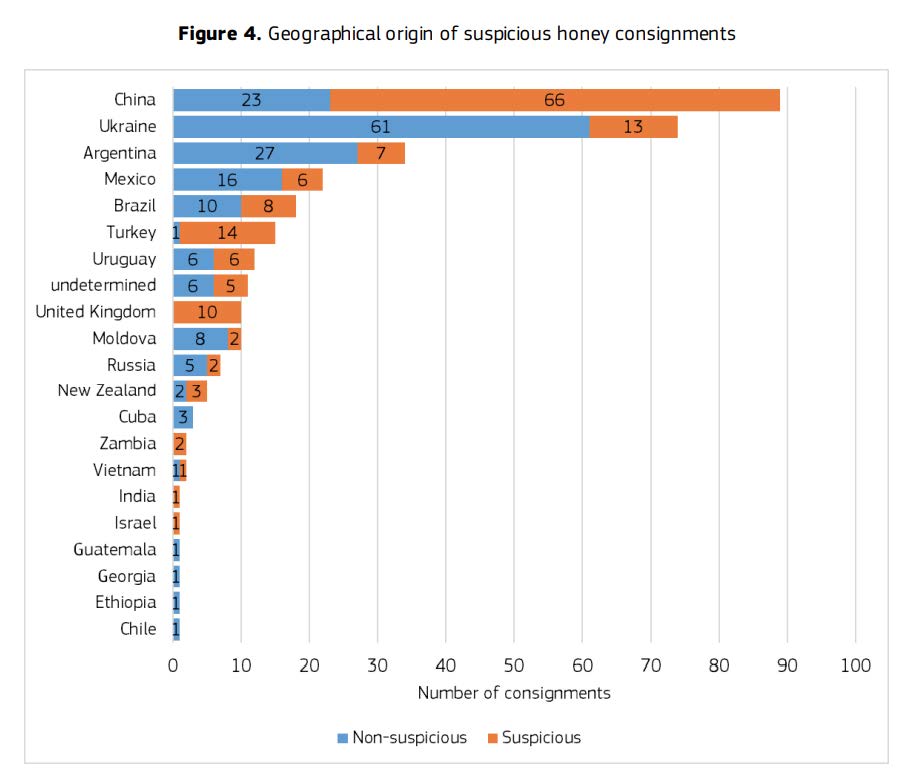
Source: EU Coordinated action to deter certain fraudulent practices in the honey sector, JRC Technical report
The EU market is flooded with syrup-based “honey”: finally putting a figure on foul play!
The European Commission published two joint reports on fraudulent practices in imports of honey into the EU. According to investigations, 46% of the collected samples were suspected of being adulterated with added syrups. This dramatic situation has been denounced by Copa and Cogeca for years now. Yet solutions are known and unanimously supported by the sector: it is high time for the EU to act!
Thanks to joint work by DG Sante, JRC and OLAF, the Commission has quantified an alarming reality: of the 320 samples received from competent national authorities, 147 (46%) were suspected of non-compliance with the requirements of the EU Honey Directive. Almost 74% of the Chinese, 93% of the Turkish and 100% of the British honey samples were considered “suspicious”!
Read the full Press Release here: Press Release
]]>